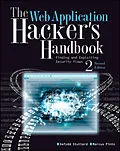The highly successful security book returns with a new edition, completely updated
Web applications are the front door to most organizations, exposing them to attacks that may disclose personal information, execute fraudulent transactions, or compromise ordinary users. This practical book has been completely updated and revised to discuss the latest step-by-step techniques for attacking and defending the range of ever-evolving web applications. You'll explore the various new technologies employed in web applications that have appeared since the first edition and review the new attack techniques that have been developed, particularly in relation to the client side.
* Reveals how to overcome the new technologies and techniques aimed at defending web applications against attacks that have appeared since the previous edition
* Discusses new remoting frameworks, HTML5, cross-domain integration techniques, UI redress, framebusting, HTTP parameter pollution, hybrid file attacks, and more
* Features a companion web site hosted by the authors that allows readers to try out the attacks described, gives answers to the questions that are posed at the end of each chapter, and provides a summarized methodology and checklist of tasks
Focusing on the areas of web application security where things have changed in recent years, this book is the most current resource on the critical topic of discovering, exploiting, and preventing web application security flaws.
Autorentext
DAFYDD STUTTARD is an independent security consultant, author, and software developer specializing in penetration testing of web applications and compiled software. Under the alias PortSwigger, Dafydd created the popular Burp Suite of hacking tools.
MARCUS PINTO delivers security consultancy and training on web application attack and defense to leading global organizations in the financial, government, telecom, gaming, and retail sectors.
The authors cofounded MDSec, a consulting company that provides training in attack and defense-based security.
Klappentext
New technologies. New attack techniques. Start hacking.
Web applications are everywhere, and they're insecure. Banks, retailers, and others have deployed millions of applications that are full of holes, allowing attackers to steal personal data, carry out fraud, and compromise other systems. This book shows you how they do it.
This fully updated edition contains the very latest attack techniques and countermeasures, showing you how to break into today's complex and highly functional applications. Roll up your sleeves and dig in.
-
Discover how cloud architectures and social networking have added exploitable attack surfaces to applications
-
Leverage the latest HTML features to deliver powerful cross-site scripting attacks
-
Deliver new injection exploits, including XML external entity and HTTP parameter pollution attacks
-
Learn how to break encrypted session tokens and other sensitive data found in cloud services
-
Discover how technologies like HTML5, REST, CSS and JSON can be exploited to attack applications and compromise users
-
Learn new techniques for automating attacksand dealing with CAPTCHAs and cross-site request forgery tokens
-
Steal sensitive data across domains using seemingly harmless application functions and new browser features
Find help and resources at http://mdsec.net/wahh
-
Source code for some of the scripts in the book
-
Links to tools and other resources
-
A checklist of tasks involved in most attacks
-
Answers to the questions posed in each chapter
-
Hundreds of interactive vulnerability labs
Inhalt
Introduction xxiii
Chapter 1 Web Application (In)security 1
The Evolution of Web Applications 2
Web Application Security 6
Summary 15
Chapter 2 Core Defense Mechanisms 17
Handling User Access 18
Handling User Input 21
Handling Attackers 30
Managing the Application 35
Summary 36
Questions 36
Chapter 3 Web Application Technologies 39
The HTTP Protocol 39
Web Functionality 51
Encoding Schemes 66
Next Steps 70
Questions 71
Chapter 4 Mapping the Application 73
Enumerating Content and Functionality 74
Analyzing the Application 97
Summary 114
Questions 114
Chapter 5 Bypassing Client-Side Controls 117
Transmitting Data Via the Client 118
Capturing User Data: HTML Forms 127
Capturing User Data: Browser Extensions 133
Handling Client-Side Data Securely 154
Summary 156
Questions 157
Chapter 6 Attacking Authentication 159
Authentication Technologies 160
Design Flaws in Authentication Mechanisms 161
Implementation Flaws in Authentication 185
Securing Authentication 191
Summary 201
Questions 202
Chapter 7 Attacking Session Management 205
The Need for State 206
Weaknesses in Token Generation 210
Weaknesses in Session Token Handling 233
Securing Session Management 248
Summary 254
Questions 255
Chapter 8 Attacking Access Controls 257
Common Vulnerabilities 258
Attacking Access Controls 266
Securing Access Controls 278
Summary 284
Questions 284
Chapter 9 Attacking Data Stores 287
Injecting into Interpreted Contexts 288
Injecting into SQL 291
Injecting into NoSQL 342
Injecting into XPath 344
Injecting into LDAP 349
Summary 354
Questions 354
Chapter 10 Attacking Back-End Components 357
Injecting OS Commands 358
Manipulating File Paths 368
Injecting into XML Interpreters 383
Injecting into Back-end HTTP Requests 390
Injecting into Mail Services 397
Summary 402
Questions 403
Chapter 11 Attacking Application Logic 405
The Nature of Logic Flaws 406
Real-World Logic Flaws 406
Avoiding Logic Flaws 428
Summary 429
Questions 430
Chapter 12 Attacking Users: Cross-Site Scripting 431
Varieties of XSS 433
XSS Attacks in Action 442
Finding and Exploiting XSS Vulnerabilities 451
Preventing XSS Attacks 492
Summary 498
Questions 498
Chapter 13 Attacking Users: Other Techniques 501
Inducing User Actions 501
Capturing Data Cross-Domain 515
The Same-Origin Policy Revisited 524
Other Client-Side Injection Attacks 531
Local Privacy Attacks 550
Attacking ActiveX Controls 555
Attacking the Browser 559
Summary 568
Questions 568
Chapter 14 Automating Customized Attacks 571
Uses for Customized Automation 572
Enumerating Valid Identifiers 573
Harvesting Useful Data 583
Fuzzing for Common Vulnerabilities 586
Putting It All Together: Burp Intruder 590
Barriers to Automation 602
Summary 613
Questions 613
Chapter 15 Exploiting Information Disclosure 615
Exploiting Error Messages 615
Gathering Published ...
